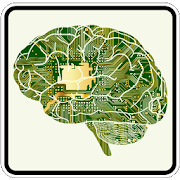4 Похожие Game theory - Brown's method
arXiv scanner 1.18
Scans downloads folder for pdf filesfromarXiv. Adds title, authors and summary and makes allthisinformation easily searchable from inside the application.Manual=======1) Long press to erase physically a paper2) Search is done simultaneously overtitles, authors and arXiv ids3) Use "&" to make composed queries (see screenshots forexamples)4) Use settings to enable search in arXivAmong supported categories are:Statistics:ApplicationsComputationMachine LearningMethodologyTheoryQuantitative Biology:BiomoleculesCell BehaviorGenomicsMolecular NetworksNeurons and CognitionOtherPopulations and EvolutionQuantitative MethodsSubcellular ProcessesTissues and OrgansComputer Science:ArchitectureArtificial IntelligenceComputation and LanguageComputational ComplexityComputational Engineering; Finance; and ScienceComputational GeometryComputer Science and Game TheoryComputer Vision and Pattern RecognitionComputers and SocietyCryptography and SecurityData Structures and AlgorithmsDatabasesDigital LibrariesDiscrete MathematicsDistributed; Parallel; and Cluster ComputingGeneral LiteratureGraphicsHuman-Computer InteractionInformation RetrievalInformation TheoryLearningLogic in Computer ScienceMathematical SoftwareMultiagent SystemsMultimediaNetworking and Internet ArchitectureNeural and Evolutionary ComputingNumerical AnalysisOperating SystemsOtherPerformanceProgramming LanguagesRoboticsSoftware EngineeringSoundSymbolic ComputationNonlinear Sciences:Adaptation and Self-Organizing SystemsCellular Automata and Lattice GasesChaotic DynamicsExactly Solvable and Integrable SystemsPattern Formation and SolitonsMathematics:Algebraic GeometryAlgebraic TopologyAnalysis of PDEsCategory TheoryClassical Analysis and ODEsCombinatoricsCommutative AlgebraComplex VariablesDifferential GeometryDynamical SystemsFunctional AnalysisGeneral MathematicsGeneral TopologyGeometric TopologyGroup TheoryHistory and OverviewInformation TheoryK-Theory and HomologyLogicMathematical PhysicsMetric GeometryNumber TheoryNumerical AnalysisOperator AlgebrasOptimization and ControlProbabilityQuantum AlgebraRepresentation TheoryRings and AlgebrasSpectral TheoryStatisticsSymplectic GeometryAstrophysicsPhysics:Disordered Systems and Neural NetworksMesoscopic Systems and Quantum Hall EffectMaterials ScienceOtherSoft Condensed MatterStatistical MechanicsStrongly Correlated ElectronsSuperconductivityGeneral Relativity and Quantum CosmologyHigh Energy ExperimentHigh Energy LatticeHigh Energy PhenomenologyHigh Energy TheoryMathematical PhysicsNuclear ExperimentNuclear TheoryAccelerator PhysicsAtmospheric and Oceanic PhysicsAtomic PhysicsAtomic and Molecular ClustersBiological PhysicsChemical PhysicsClassical PhysicsComputational PhysicsData Analysis; Statistics and ProbabilityFluid DynamicsGeneral PhysicsGeophysicsHistory of PhysicsInstrumentation and DetectorsMedical PhysicsOpticsPhysics EducationPhysics and SocietyPlasma PhysicsPopular PhysicsSpace PhysicsQuantum Physics
Artificial Intelligence 5.4
The app is a complete free handbookofArtificial Intelligence with diagrams and graphs. It is partofComputer or software engineering education which bringsimportanttopics, notes, news & blog on the subject. The Appserves as aquick reference guide on this engineering subject.It covers more than 140 topics of Artificial Intelligenceindetail. The topics are divided into 5 units.Each topic is complete with diagrams, equations and otherformsof graphical representations for better learning andquickunderstanding. The App will provide faster learning andquickrevisions on the subject.Some of the topics Covered in this application are:1. Turing test2. Introduction to Artificial Intelligence3. History of AI4. The AI Cycle5. Knowledge Representation6. Typical AI problems7. Limits of AI8. Introduction to Agents9. Agent Performance10. Intelligent Agents11. Structure Of Intelligent Agents12. Types of agent program13. Goal based Agents14. Utility-based agents15. Agents and environments16. Agent architectures17. Search for Solutions18. State Spaces19. Graph Searching20. A Generic Searching Algorithm21. Uninformed Search Strategies22. Breadth-First Search23. Heuristic Search24. A∗ Search25. Search Tree26. Depth first Search27. Properties of Depth First Search28. Bi-directional search29. Search Graphs30. Informed Search Strategies31. Methods of Informed Search32. Greedy Search33. Proof of Admissibility of A*34. Properties of Heuristics35. Iterative-Deepening A*36. Other Memory limited heuristic search37. N-Queens eample38. Adversarial Search39. Genetic Algorithms40. Games41. Optimal decisions in Games42. minimax algorithm43. Alpha Beta Pruning44. Backtracking45. Consistency Driven Techniques46. Path Consistency (K-Consistency)47. Look Ahead48. Propositional Logic49. Syntax of Propositional Calculus50. Knowledge Representation and Reasoning51. Propositional Logic Inference52. Propositional Definite Clauses53. Knowledge-Level Debugging54. Rules of Inference55. Soundness and Completeness56. First Order Logic57. Unification 58. Semantics59. Herbrand Universe60. Soundness, Completeness, Consistency, Satisfiability61. Resolution62. Herbrand Revisited63. Proof as Search64. Some Proof Strategies65. Non-Monotonic Reasoning66. Truth Maintenance Systems67. Rule Based Systems68. Pure Prolog69. Forward chaining70. backward Chaining71. Choice between forward and backward chaining72. AND/OR Trees73. Hidden Markov Model74. Bayesian networks75. Learning Issues76. Supervised Learning77. Decision Trees78. Knowledge Representation Formalisms79. Semantic Networks80. Inference in a Semantic Net81. Extending Semantic Nets82. Frames83. Slots as Objects84. Interpreting frames85. Introduction to Planning86. Problem Solving vs. Planning87. Logic Based Planning88. Planning Systems89. Planning as Search90. Situation-Space Planning Algorithms91. Partial-Order Planning92. Plan-Space Planning Algorithms93. Interleaving vs. Non-Interleaving of Sub-Plan Steps94. Simple Sock/Shoe Example95. Probabilistic Reasoning96. Review of Probability Theory97. Semantics of Bayesian Networks98. Introduction to Learning99. Taxonomy of Learning Systems100. Mathematical formulation of the inductivelearningproblem101. Concept Learning102. Concept Learning as Search103. Algorithm to Find a Maximally-Specific Hypothesis104. Candidate Elimination Algorithm105. The Candidate-Elimination Algorithm106. Decision Tree Construction107. Splitting Functions108. Decision Tree Pruning109. Neural Networks110. Artificial Neural Networks111. Perceptron112. Perceptron Learning
Mathinary math
Math topics carefully written to make iteasyto understand math, calculators that give explanationsandintermediate results, and a collection of formulas. Doesnotrequire network access.Mathinary is a powerful educational math tool for studentsandparents who help their children with math.Mathinary contains formulas, explanations and calculators.Thecalculators give explanations, intermediate results andfinalresults. The calculators are simulating how a personwouldcalculate the result, by showing every step of thecalculationincluding descriptions.The topics in Mathinary are described with text, which hasbeencarefully written to avoid difficult words, and making itsimplefor students and their parents to understand math.Mathinary is an invaluable app for children in school, theirparentsand others who needs help with math or those who just wantstofreshen up their knowledge.Mathinary is concentrated on math in school from the 5th tothetenth grade, but is also covering topics used inhighereducations.Topics covered:* PLANE GEOMETRYAnnulus, circle, circle sector, circle segment, lines andpoints,parabola, parallelogram, polygon, quadrilateral,rectangle,rhombus, square, trapezoid, triangle, unit circle,vectors* SOLIDSCone, frustum cone, cylinder, parallelepiped, prism,pyramid,frustum pyramid, sphere* CONVERSIONSArea, currency, degrees and radians, length, scale, speed,timeperiods, time units, volume* FINANCEAnnuity loan, annuity savings, currency conversion, futurevalue,percentage, value added tax* Numbers & AlgebraAddition - long, binary numeral system, divisibility rules,division– long, exponents, fractions, linear equation,multiplication –long, order of operations, parentheses, quadraticequation, romannumerals, roots, sets of numbers, simplification,subtraction–long* FunctionsExponential functions, inversely proportional function,linearfunction, power function, proportional function,quadraticfunction* Probability & statisticsBinomial distribution, charts, combinatorics,observations,probability, set theory* TablesFractions / least common denominator, multiplication10x10,multiplication 12x12, multiplication 20x20* Math gamesMultiplication game, order of operations gameThe developers can be contacted within the app, in thesection“ABOUT” and then “Contact us”



